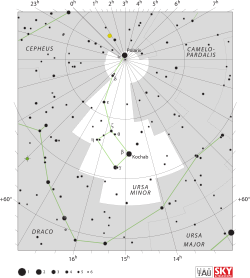Polaris
| Observation data Epoch J2000 Equinox |
|
|---|---|
| Constellation | Ursa Minor |
| α UMi Aa | |
| Right ascension | 02h 31m 49.09s |
| Declination | +89° 15′ 50.8″ |
| Apparent magnitude (V) | 1.98 |
| α UMi Ab | |
| Right ascension | |
| Declination | |
| Apparent magnitude (V) | 9.2 |
| α UMi B | |
| Right ascension | 02h 30m 41.63s |
| Declination | +89° 15′ 38.1″ |
| Apparent magnitude (V) | 8.7 |
| Characteristics | |
| α UMi Aa | |
| Spectral type | F7Ib |
| U−B color index | 0.38 |
| B−V color index | 0.60 |
| Variable type | Classical Cepheid |
| α UMi Ab | |
| Spectral type | F6V |
| α UMi B | |
| Spectral type | F3V |
| U−B color index | 0.01 |
| B−V color index | 0.42 |
| Astrometry | |
| Radial velocity (Rv) | −17 km/s |
| Proper motion (μ) |
RA: 44.48±0.11 mas/yr Dec.: −11.85±0.13 mas/yr |
| Parallax (π) | 7.54 ± 0.11mas |
| Distance | 323–433ly (99–133pc) |
| Absolute magnitude (MV) | −3.6 (α UMi Aa) 3.6 (α UMi Ab) 3.1 (α UMi B) |
| Orbit | |
| Primary | α UMi Aa |
| Companion | α UMi Ab |
| Period (P) | 29.59 yr |
| Semi-major axis (a) | 0.133" |
| Eccentricity (e) | 0.608 |
| Inclination (i) | 128° |
| Longitude of the node (Ω) | 19° |
|
Argument of periastron (ω) (secondary) |
303° |
|
Semi-amplitude (K1) (primary) |
3.72 km/s |
| Details | |
| α UMi Aa | |
| Mass | 5.4 M☉ |
| Radius | 37.5 R☉ |
| Luminosity (bolometric) | 1,260 L☉ |
| Surface gravity (log g) | 2.2 cgs |
| Temperature | 6015 K |
| Metallicity | 112% solar |
| Rotation | 119 days |
| Rotational velocity (v sin i) | 14 km/s |
| Age | 7×107 years |
| α UMi Ab | |
| Mass | 1.26 M☉ |
| Radius | 1.04 R☉ |
| Luminosity (bolometric) | 3 L☉ |
| Age | 7×107 years |
| α UMi B | |
| Mass | 1.39 M☉ |
| Radius | 1.38 R☉ |
| Luminosity (bolometric) | 3.9 L☉ |
| Surface gravity (log g) | 4.3 cgs |
| Temperature | 6900 K |
| Rotational velocity (v sin i) | 110 km/s |
| Age | 7×107 years |
| Position (relative to α UMi Aa) | |
| Component | α UMi Ab |
| Epoch of observation | 2005.5880 |
| Angular distance | 0.172″ |
| Position angle | 231.4° |
| Position (relative to α UMi Aa) | |
| Component | α UMi B |
| Epoch of observation | 2005.5880 |
| Angular distance | 18.217″ |
| Position angle | 230.540° |
| Other designations | |
| Database references | |
| SIMBAD | α UMa A |
| α UMa B | |
Polaris, designated Alpha Ursae Minoris (α Ursae Minoris, abbreviated Alpha UMi, α UMi), commonly the North Star or Pole Star, is the brightest star in the constellation of Ursa Minor. It is very close to the north celestial pole, making it the current northern pole star. The revised Hipparcos parallax gives a distance to Polaris of about 433 light-years (133 parsecs), while calculations by other methods derive distances around 30% closer.
Polaris is a multiple star, comprising the main star (Polaris Aa, a yellow supergiant) in orbit with a smaller companion (Polaris Ab); the pair in orbit with Polaris B (discovered in 1780 by William Herschel). There were once thought to be two more distant components—Polaris C and Polaris D—but these have been shown not to be physically associated with the Polaris system.
Polaris Aa is a 4.5 solar mass (M☉) F7 yellow supergiant of spectral type Ib. This is the first classical Cepheid to have a mass determined from its orbit. The two smaller companions are Polaris B, a 1.39 M☉ F3 main-sequence star orbiting at a distance of 2400 astronomical units (au), and Polaris Ab (or P), a very close F6 main-sequence star with an 18.8 au radius orbit and 1.26 M☉.
...
Wikipedia

